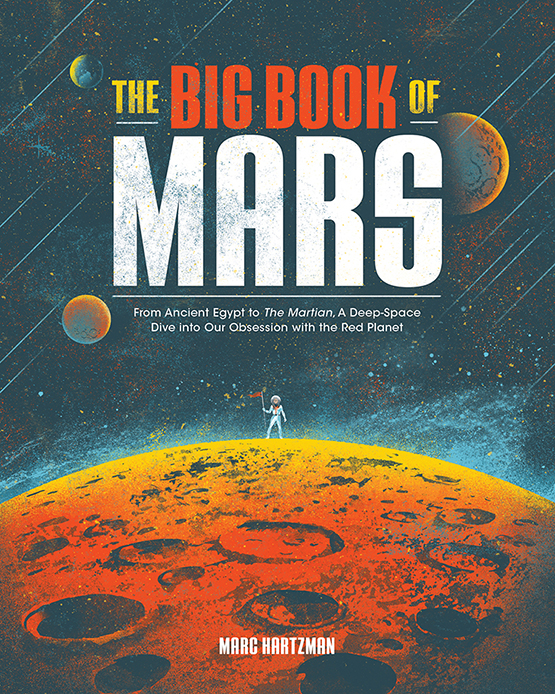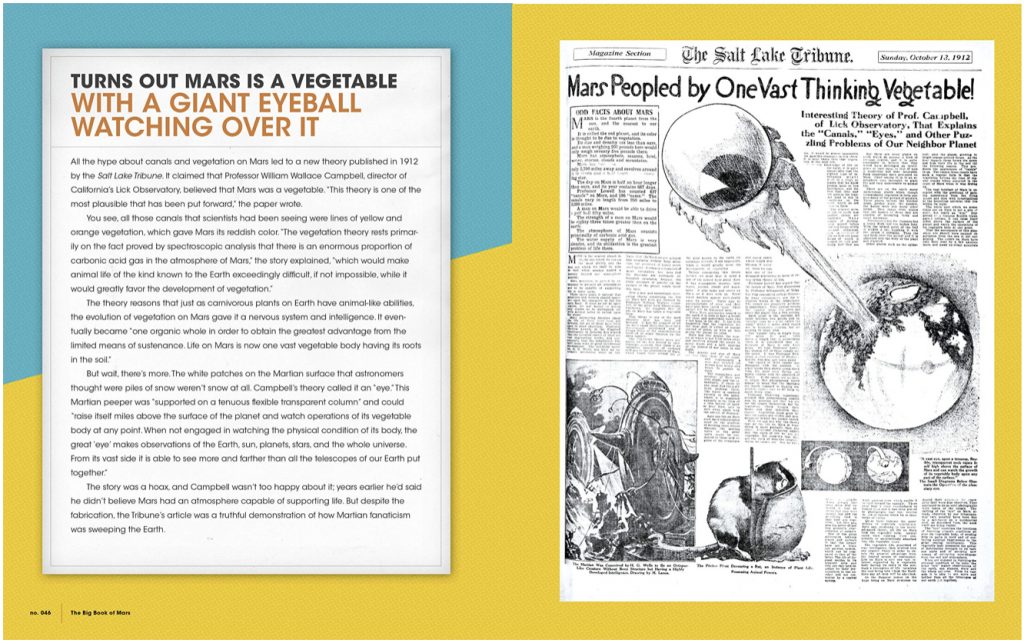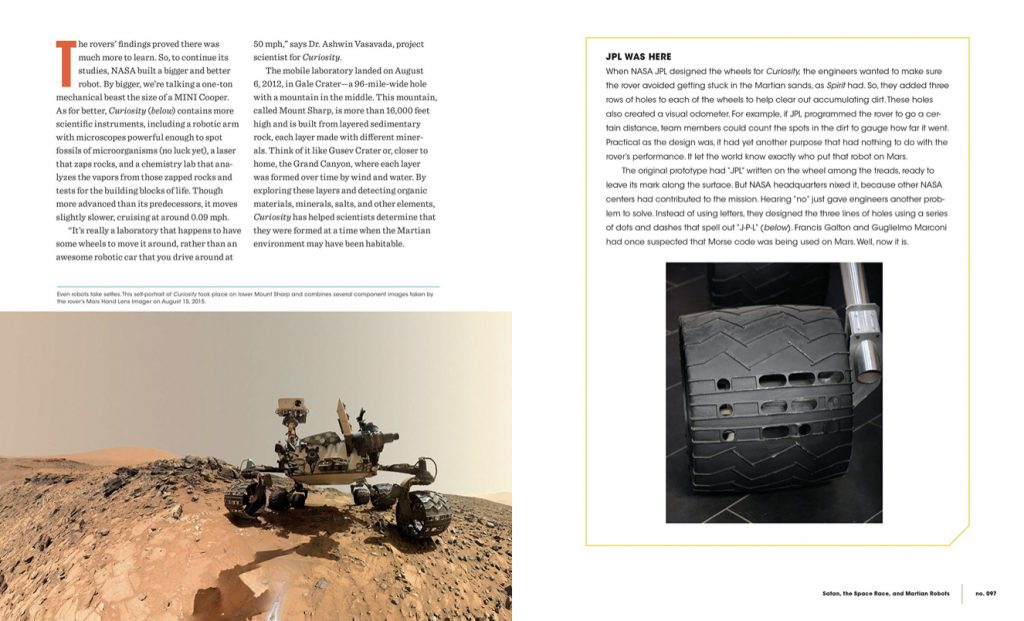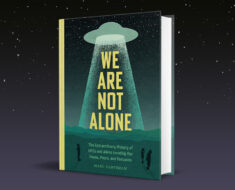
A few years ago I was looking for something to write about for Weird Historian. I had remembered reading something about Nikola Tesla’s attempts to make contact with Mars in the early twentieth century, and thought, well, that’s a good piece of weird history. So I looked it up in a newspaper archive and stumbled onto another story, about a man who claimed to be in telepathic communication with a Martian woman named Ooomaruru. I was fascinated and dug into that story instead.
I wrote a brief article for this site, then did a more thorough version for Mental Floss. The more I researched it, the more I learned about other Martian beliefs at the time and the greater my fascination became. It all led to a book project called The Big Book of Mars, being published by Quirk Books, due out July 7, 2020—just in time for the Mars Perseverance launch.
In addition to Oomaruru and other tales of attempts to communicate with Martians, the book covers our obsession with the fourth planet from the sun dating back thousands of years, beginning with the Ancient Egyptians. Since then, Mars has drawn countless scientists, novelists, filmmakers, and entrepreneurs to imagine the impossible: life beyond Earth.
I hope you’ll find these stories of our interplanetary neighbor as interesting I do. You can buy a copy on bookshop.org, Amazon, at Barnes & Noble, or wherever you buy books. Your Weird Historian would appreciate the support! In the meantime, below is an excerpt from The Big Book of Mars.

IN THE BEGINNING
Once upon a time, the planet Mars was a wondrous place filled with intelligent beings. Standing ten to twenty feet tall, these brilliant Martians feverishly dug canals to irrigate their dry planet and desperately tried to contact us, the people of Earth.
Some hundred years ago, that’s what the greatest minds in the world believed, and so it was. This was an era when telephones, automobiles, airplanes, radios, and television were new and magical wonders. The impossible, it seemed, was never more possible. So, when newspapers spread scientific theories and hyped the next big advance—communication with Martians—people thought, why not? The long-distance phone bills would cost a fortune, but still, what a time to be alive!
I discovered this peculiar period of interplanetary excitement while researching Nikola Tesla’s attempts to communicate with our supposed neighbors. In the process I stumbled upon someone who’d claimed to already be hobnobbing with them. His name was Dr. Hugh Mansfield Robinson, and in the 1920s he was in touch with a big-eared, nearly seven-foot-tall Martian woman named Oomaruru. Telepathically.
Forget Tesla. Who was this Robinson guy?
I switched my focus and dug into this other story. For someone who likes writing about weird history, this was striking gold. Robinson’s conversations with Oomaruru made headlines all around the world. Earth was fascinated with all things Mars, regardless of who was offering it.
The obsession with the Red Planet goes back even further, to a time long before the early twentieth century. Thousands of years ago, at least, when its red color conjured images of bloodshed instead of the oxidized iron dust covering its surface. Ancient Egyptian astronomers noticed the fiery orb’s retrograde motion and named it Har Decher, meaning “the Red One.”
As time trudged forward, other curious civilizations gave it their own names based on its blazing visage. Chinese astronomers saw the “fire star” and considered it a sign of “bane, grief, war and murder.” The Hebrews called it Ma’adim, from their word for red, adom. They believed that those born under the influence of Mars would enter bloody occupations, such as murder, the military, or surgery. By 600 BCE, the Babylonians dubbed it Nergal, after their god of war and destruction. Bloodshed became the presumptuous theme for the Red Planet. For whatever barbaric acts these peoples were committing in their own kingdoms, they must’ve thought all hell was breaking loose on faraway Mars.
When the Babylonians gazed at the skies to develop a calendar, they created the seven-day week and named each day for a known celestial body: the sun, the moon, Mars, Mercury, Venus, Jupiter, and Saturn. The day attributed to Mars is Tuesday (the association is more apparent in Spanish, in which the day is known as Martes); its association with war and aggression led them to perform special rituals on Tuesdays to avoid hostile influence from the Red Planet. Thousands of years later, Mars remains in our lives at least once a week.
In the mid-300s BCE, while pondering, well, everything, Aristotle observed the moon passing in front of Mars, which led him to conclude that it, and the other planets, were farther away from Earth. In the meantime, he and the rest of Greek civilization carried on the tradition and named the Red Planet Ares, after their own god of war. The son of Zeus and Hera, Ares represented the unfortunate but necessary brutality and violence of battle. Ares’s two sons, Phobos and Deimos (meaning “fear” and “terror,” respectively), would lend their names to the two moons of Mars after their 1877 discovery by astronomer Asaph Hall.
All these gods of war eventually lost the planet-naming contest to the Roman deity, Mars. The planet’s mystique mirrored their affinity for power and bloody paths of conquest. But as far as the Roman astronomer Claudius Ptolemy was concerned, Mars was just a soldier in the earthly universe. It, along with the sun and other celestial bodies, revolved around us. His theories, known as the Ptolemaic System, reigned for the next 1,400 years, until Copernicus proclaimed a different idea about the organization of the solar system. From then on, observations about Mars grew more detailed, and the obsession with what secrets lay across the cosmos grew exponentially. Were we alone in the universe, or were other civilizations staring right back at us wondering the same thing?
The Big Book of Mars examines the many enthusiastic answers offered by some of history’s greatest and most creative minds—from Nikola Tesla and Guglielmo Marconi to H. G. Wells, Ray Bradbury, and many more, including a bunch of confident UFO spotters.
As I dug into the Dr. Mansfield Robinson story, I found stories about others who believed that communication with Martians was inevitable—and could happen any day. I suddenly found myself obsessed with their obsession, and I wanted to learn more about these theoretical Martians and where all the ideas about talking to them came from. My own journey was just beginning. I scoured newspaper archives and discovered countless articles, most speculating about the existence of canals on the surface of Mars. That fantastically wrong belief, born in the nineteenth century, inspired the imaginations of Wells, Edgar Rice Burroughs, and other early science-fiction writers. Their stories, and those of many others, inspired the next generation of scientists who were determined to invent the space travel their favorite writers had imagined. And so they did. Science leads to science fiction, and science fiction leads to science. It’s a symbiotic relationship.
Like those geniuses who turned imaginations into reality, I devoured as many Mars-related science-fiction books as I could and watched a lot of movies (mostly bad ones), from The Wizard of Mars to Santa Claus Conquers the Martians. I also made a pilgrimage to the place where engineering feats happen all the time: the NASA Jet Propulsion Laboratory in Pasadena, California. The sprawling JPL campus is home to the dedicated teams who have been making journeys to Mars possible since the 1960s. The mission control room is surrounded by laboratories, testing areas, and the kinds of signs you just don’t find on other tours, like “Mars Yard” and “Planetary Landing Testbed.” Even though this close-knit bunch of men and women are busily writing the sci-fi movie that we’re all living in, they know how to take a break from equations and algorithms. I know this, having witnessed a group of them playing their trumpets in a room adjacent to a robotics lab.
Smart as they are, they’ve yet to build a time machine, although visiting the Lowell Observatory in Flagstaff, Arizona, felt as though I’d stepped into one. Rummaging through Percival Lowell’s personal scrapbooks, drawings, and notes from 1894 through the early 1900s, and looking through a telescope at Mars in the spot where Lowell so often did, was definitely a step back to an incredibly exciting time in Earth–Mars history. As was standing on the spot in Grover’s Mill, New Jersey, where the Martians began their invasion on October 30, 1938, during Orson Welles’s radio broadcast of The War of the Worlds. The town’s commemoration of the fictional attack has transformed the terrifying event into nostalgic pride.
These moments are just a small part of my treasure hunt through history, which included many conversations with the people who’ve helped pave the interplanetary road to Mars that sends us photos from its surface every day. (At one point, that idea would’ve sounded as crazy as the concept of telepathy with a giant Martian woman named Oomaruru.)
Assuming the space community reaches its goal of putting humans on Mars by the 2030s, the first person to take that historic step is already among us. To that person I say, may this book serve as a guide through humanity’s history with the Red Planet—until you write the next chapter.





![Toby The Sapient Pig, 1817 [Public domain], via Wikimedia Commons](https://www.weirdhistorian.com/wp-content/uploads/2017/05/Tobythesapientpig-1871-crop-235x190.jpg)

